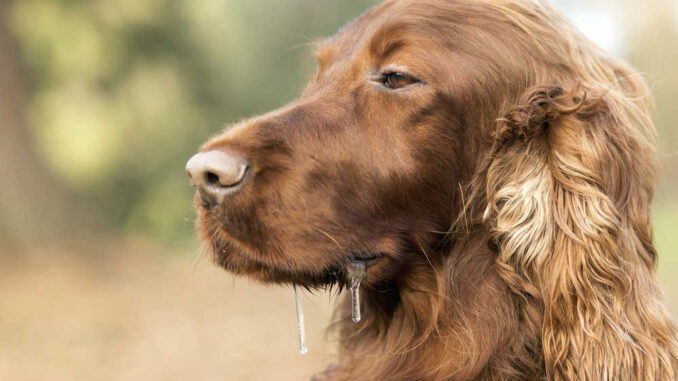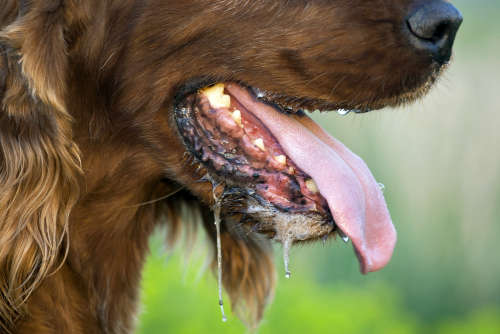
Excessive drooling and shaking are two common concerns of our clients.
First, evaluate if your dog’s drooling is “excessive” or unusual
How much doggy drool is normal? That’s a question I often get at the overnight veterinary clinic where I work as a veterinary technician. The amount of drool that is considered “normal” varies. You should get to know early on what is normal for your dog.
Some breeds are known to be “droolers”, Mastiffs, Danes, Bulldogs, Newfoundlands and Labradors among therm. In general:
- The drool shouldn’t leave a puddle or soak the front of your dog’s chest.
- Little wet spots here and there are ok. Active drooling should stop after a few minutes.
There are a multitude of reasons why a dog may drool or shake. Sometimes these signs are indicative of a serious illness. If you do believe your dog’s drool is abnormal, it’s time to act.
First, make sure your dog is calm & not overheated
- If your dog is drooling or shaking after running around too much or being overly excited calm them down and once calm give them some water.
- If they are overheating in the sun bring them inside or provide them with shade and give them some water.
If your dog continues to drool or shake even once calm and cooled, you should put in a call to your vet: there are a few life-threatening conditions where drooling and or shaking may be the first signs you see.
In particular, if you should call your vet if you notice any additional symptoms such as vomiting, diarrhea, panting, pacing, loss of appetite, or any other signs of discomfort of illness.
Life-threatening emergencies causing drooling and or shaking
If you suspect that any of the following are what is going on with your dog, call a veterinarian immediately.
1. Twisted stomach
A twisted or flipped stomach (gastric torsion, or GDV) can happen to any dog, but is prevalent in deep chested dogs such as Great Danes and German shepherds. In addition to drooling and trembling you may see a bloated abdomen, retching up white foam, panting or pacing. Learn more.
2. Intestinal blockage
Drooling and or shaking can be seen in dogs with intestinal blockages. You may also see vomiting, hunched posture or “prayer position” (hind end in air, face and forelimbs on floor) and an inability to get comfortable. Other symptoms include loss of appetite, abdominal pain, and inability to defecate or passing diarrhea. Learn more. Learn more.
3. Sepsis
Sepsis is a serious systemic infection that can cause drooling and shaking. Any infection can lead to sepsis. You may also see vomiting, inappetence, fever, weakness and confusion. Learn more.
4. Esophageal foreign body
Dogs sometimes get toys or bones stuck in their esophagus. This may cause them to drool and tremble. You may see your dog paw at their face or retch. They will refuse to eat.
This is an emergency. If not removed the foreign body can cause serious damage to the esophagus. Sometimes the object can be removed via endoscopy, other times surgery is necessary.
5. Hyperthermia/heat stroke
Dogs drool when they are hot, if the drooling is excessive get your dog into a cool area and give him or her some water. You can also cool a dog by wetting their hair with cool not cold water. If they are weak, shaking, or vomit call your vet as true heat stroke requires immediate veterinary attention.
If your dog’s rectal temp is higher than 104, call a veterinarian as if it goes much higher they are in real danger.
When taking your dog’s temperature it is advised to use a plastic thermometer and have someone hold your dog’s head as you place the thermometer in your dog’s rectum. Don’t forget some lubricant. You can use petroleum or KY jelly or even vegetable oil. Insert the thermometer in about one inch depending on the size of your dog. If your dog is threatening to bite or putting up a big fight, stop before causing too much stress. Call your vet and ask for advice. see this link for more info on heatstroke.
6. Hypoglycemia
Low blood sugar or hypoglycemia can cause trembling. Low blood sugar will lead to seizures and death if not corrected. Young puppies and small breed dogs are susceptible to this. If you suspect low blood sugar (young pup not eating well, or small breed dog suddenly trembling, lethargic or vomiting) rub some caro syrup or pancake syrup on your dog’s gums and get to a veterinary hospital right away. Do not pour the caro syrup into your dog’s mouth. He or she may not be able to swallow in this condition.
7. Toxin exposure
Contact with some insecticides, ingestion of certain plants such as azaleas, rhododendrons and iris and some chemicals will cause hypersalivation and shaking, as well as some prescription drugs, over the counter medications, recreational drugs and chocolate toxicity.
If you think it is possible that your dog was exposed to a toxin, call a veterinarian right away. Don’t delay as some toxins can be deadly.
If you think that you know what your dog ate, you can call a poison control hotline. There is a fee for this but it is well worth the money. If they recommend veterinary care they will consult with your veterinarian.
Treatment of most toxins includes inducing vomiting (don’t do this at home! Some chemicals are caustic and can burn the throat and mouth), IV fluids, toxin binders, GI protectants, pain medication and ECG monitoring.
8. Seizures
Dogs that are having seizures will often tremble or drool prior to a seizure or during the post ictal stage which is the time immediately following a seizure.
If your dog is having seizures call a veterinarian right away.
Status epilipticus is a seizure that lasts for more than 5 minutes, more than one seizure in 5 minutes or multiple seizures without regaining consciousness between them. Dogs in this situation are at risk for heat stroke or brain death, both life threatening.
Non-life threatening causes of drooling and shaking

1. Nausea
Dogs often drool and occasionally tremble when they are nauseous. Other signs of nausea you may see include: licking of the lips, excessive or “hard” swallowing, refusal to eat, vomiting or regurgitation.
There are many reasons a dog may be nauseous, some requiring immediate veterinary attention. If your dog’s nausea is enough to cause hypersalivation you should seek veterinary help.
Causes of nausea include: gastroenteritis, pancreatitis, intestinal obstruction, kidney disease, liver disease, motion sickness, GDV.
2. Anxiety or fear
When a dog is nervous they may drool and shake. Any of the following can cause anxiety:
- Rain
- Strangers around the house
- Construction
- Fireworks
- Loud party
- Separation anxiety
- New addition to the family
- Fighting/tension between members of the household
Try looking and listening from your dog’s perspective to figure out what they are afraid of.
If you feel that your dog’s anxiety is making their life difficult talk to your veterinarian. There are drugs to deal with canine anxiety. Also consider “Thunder shirts”. Another option is to see a veterinary behaviorist who is well versed in canine anxiety.
3. Pain
Some dogs will drool and tremble with even minor pain. Severe abdominal pain may indicate a surgical emergency and you should seek veterinary help right away. Signs of abdominal pain include: tense belly, guarding of belly, biting at sides, inability to get comfortable, whining, panting, a hunched posture or displaying the “prayer “position” (hind end up in the air with front limbs and head on the floor).
4. Dehydration
Mild dehydration causes drooling. Offer your dog some water. If your dog won’t drink or can’t keep water down, call your veterinarian right away. As dehydration progresses the drooling may stop due to a lack of available body fluid. If your dog drools and becomes lethargic or vomits call your veterinarian right away. Severe dehydration can lead to death.
5. Breed specific shaking
Certain breeds have a tendency to tremble at the slightest bit of excitement. Chihuahuas and Italian greyhounds are two breeds that display this behavior. The shaking should go away quickly when the stimulation is over.
6. Age related hind end shaking
Older dogs sometimes get tremors in their hind end due to muscle weakness and orthopedic issues.
7. Obstruction of the throat
When something is blocking the back of the mouth you will see excessive drooling.
Potential causes of throat obstruction:
- Enlarged lymph nodes or salivary glands
- Mass or tumor
- Foreign object (toy, stick…)
If the throat is blocked by lymph nodes, salivary glands or a tumor the onset of signs is typically slow. You may also notice difficulty eating, pawing at the face or a foul odor coming from the mouth. While not an emergency your dog needs to be seen by a vet as soon as possible.
If a foreign object is causing the obstruction this is a medical emergency.
8. Oral or dental disease
Dogs with dental disease; cracked teeth, oral ulcers, or abscessed tooth roots can hypersalivate. You may notice foul breath or difficulty eating. You should have your dog seen when possible as dental disease can lead to kidney or heart disease.
9. Oral foreign body
A foreign object such as a stick, bone or toy lodged somewhere in the mouth can cause drooling and trembling due to discomfort. If you think this may be what is going on bring your dog to a hospital where they can be sedated and a proper oral exam done.
10. Nerve damage
Damage to the nerves of the tongue, mouth, face and jaw can result in excessive drooling, Usually dogs with this type of problem will have difficulty eating. Nerve damage can be secondary to trauma or develop for unknown reasons.
This is not an emergency, but you should have your dog seen by a veterinarian as soon as you are able.
11. Kidney disease
Dogs with kidney disease may tremble due to electrolyte imbalances , and may drool due to nausea. While not an emergency they should be taken to a vet as soon as possible as early treatment gives a better chance of recovery.
12. Hypothermia (too cold) or fever
Dogs tremble when they are cold or have a high fever. They also may drool or pant with a high fever.
Normal dog temp is 100.0 F to 102.5F. If your dog’s temperature is a little low (98-99) and the air temp is cold cover your dog with a blanket and see if that helps. If the temperature is below 98.0 it is concerning and a sign you should call a vet.
If your dog has a mild fever, call your vet when they are open. If the temp is above 103.5 call an emergency vet because if it climbs much higher you are getting into a dangerous situation.
13. Distemper
Distemper is a potentially deadly virus. Fortunately we have a vaccine for it. Young puppies and unvaccinated dogs are susceptible. Trembling is often seen. You may also see drooling, discharge from the eyes and nose, coughing, vomiting or diarrhea. The best chance of survival depends on veterinary care, if you suspect distemper isolate your dog from other canines and call a vet right away.
How much is this going to cost me?
The current average veterinary exam fee is $50 to $90, $100 to $190 for an emergency visit. Prices will vary by location.
For nausea or abdominal pain, the veterinarian may recommend radiographs (x rays). The average cost for radiographs is $100 to $400.
Blood work is recommended for many disease processes including liver disease, kidney disease, acute abdominal pain, sepsis and seizures. Prices for blood tests range from $50 to $300.
An overnight stay in the hospital can cost from $400 to $1700 a night. This should include an intravenous or IV catheter, IV fluids and most medications.
Current average total hospital bills for these conditions:
GDV (twisted stomach)- $1,500 to $7,500
Heat stroke- $1,200 to $5,500
Intestinal blockage- $800 to $7,000
Seizures- $500 to $5,000
Toxin- $200 to $5,000
Gastroenteritis- $200 to $3,000
Pancreatitis- $200 to $5,000
Liver or kidney disease- $300 to $3000
The large price range reflects both the difference in hospitals as well as the severity of the illness.
If you have money considerations let the vet know. They may be able to recommend a low cost clinic or credit options.
Telehealth appointments may be a good option to get started. The price on average is 50 dollars for a single exam, or 10 to 50 dollars a month for multiple visits. They are available 24/7. If you are hours away from a clinic it may save you a long drive.
While the telehealth vet is limited by not being able to do diagnostics such as lab work, radiographs and ultrasound there is a lot they can do such as an overall visual assessment noting the respiratory rate and effort, gum coloration and mental status. They can teach you to feel a pulse and take a heart rate.
They will then make recommendations which may involve seeing an emergency vet or your regular vet when available. They may recommend you monitor your dog at home and call them back if the condition worsens.
Disclaimer: This website's content is not a substitute for veterinary care. Always consult with your veterinarian for healthcare decisions. Read More.


Be the first to comment